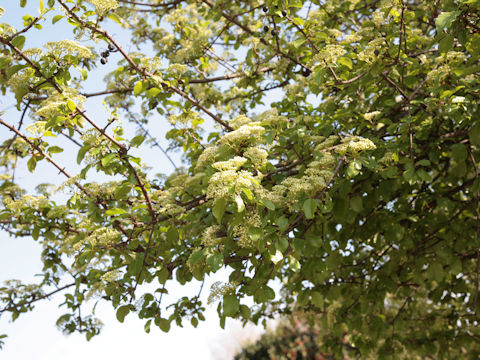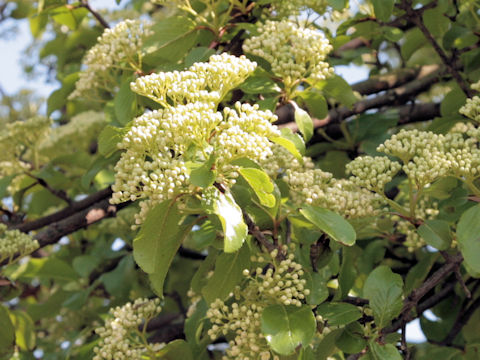 |




|

|
北アメリカの東部に分布しています。開けた森や丘陵、川岸などに生え、高さは3〜5メートルほどになります。茎は直立し、よく分枝します。葉は楕円形で先端は尖り、縁には細かい鋸歯があります。また葉柄には翼があります。4月から5月ごろ、上部が平たい集散花序に白色の花を咲かせます。果実は液果に似た核果で、秋に青黒く熟します。この果実は冬まで残ることが多く、鳥や野生動物の餌となります。また、果実は食用になり、熟したものは生食やジャムやゼリーに利用されます。種小名は、小枝が非常に丈夫で柔軟であることから、ラテン語でフレキシブルを意味します。英名は、雌ヤギがこの果実をよく食べると言うことから。
|

|
スイカズラ科ガマズミ属の落葉低木で、学名は Viburnum lentago。英名は Nannyberry。
|

|
The Nannyberry (Viburnum lentago) belongs to Caprifoliaceae (the Honeysuckle family). It is a small deciduous tree that is distributed in the eastern part of North America. It grows in open forests, hillsides, and along river banks, and grows 3 to 5 m tall. The stems are erect and well branched. The leaves are elliptic with pointed tips and finely serrated edges. White flowers bloom in flat-topped cymes from April to May. The fruit is a berry-like drupe that ripens in fall. The fruit often remains until winter and is used as food for birds and wildlife. The fruits are also edible, and the ripe ones are eaten raw or used to make jams and jellies. The specific epithet "lentago" means flexible in Latin, as the twigs are very tough and flexible. The English name comes from the fact that nanny-goats often eat this fruit.
|

|
アメリカ・テキサス州「ダラス植物園」にて、2008年03月21日撮影。(photo by Jon Suehiro)
|

